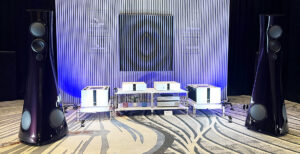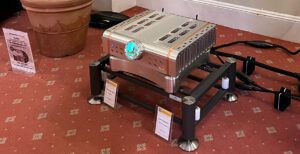
There’s a famous inscription on the James Farley Post Office that fits, It reads, “Neither snow nor rain nor heat nor gloom of night stays these couriers from the swift completion of their appointed rounds.”
It doesn’t mention Norovirus. Probably for good reason.
Having rebooted my digestive system, and despite loudspeaker and turntable round-ups still to come, it’s time to look back on the annual CES in Las Vegas. The show is constantly awash with thousands of new technologies in all consumer electronics categories striving for column inches online or in print. With an endless stream of wearable tech, curved smartphones and smart TVs, and cars with an IQ 50 points higher than their owners, it’s hardly surprising that seemingly sleepy, old-fashioned grandpa of consumer electronics – audio – barely gets a look in. Sure, the mainstream journalists and bloggers might latch onto the big talking points or the even bigger tickets in high-end audio, but for the most part the best sounding high-end system just isn’t as soundbyte-friendly or as shiny as the main attractions .
We specialists can get carried away in the event to see the bigger picture, but pulling back a while to take in both the trends and the show itself (more accurately, ‘shows’ – there’s T.H.E. Show running in parallel to contend with too).
For once, discussing attendance figures is slightly unfair. Numbers were down this year, but that was thanks to two-thirds of the US suddenly exposed to freezing weather and snowstorms blanketing the Eastern seaboard and into the Midwest. Those scheduled to attend the show from these states – and even those from far away places who had connecting flights into New York and Chicago – were left stranded, and that thinned down the number of people attending the show as a whole. Those who were there were putting a positive spin on this, saying it was all about quality, not quantity, but in reality it was more about the Polar Vortex.
Nevertheless, there were distinct trends taking place. This year, there seemed to be fewer turntables playing than usual. There were turntables on show, and many of them were in system and playing, but less than usual. In particular, those with no axe to grind either way (as in people showing off amplifiers and loudspeakers, rather than a turntable or a digital front end of some description) were in the main more content to play music from a laptop or networked source than install a turntable. Not sure why this should be, especially as vinyl replay is something of a hot topic at the moment. Perhaps it had something to do with High Resolution Audio (HRA).
2014 is supposedly the year HRA catches the interest of more than just the audiophile contingent. However, if early reports from the mainstream press are anything to go by, the movement didn’t make anything like the impact expected, and the format received the merest nod from the news media and a whole lot of ‘meh!’ from the tech press. The exception – as in hindsight, might have been predicted – was the Astell & Kern AK240 portable player, which was received with a kind of semi-quizzical ‘so it’s a super iPod?’ questioning.
Nevertheless, among the high-end audio contingent, HRA was far better received. From a hardware perspective, a slew of new servers, portables, DACs and networked audio devices appeared, capable of hitting DSD or even DSD 128 resolution. In fact, almost overnight the market has changed to adopt DSD so dramatically, a company launching a new DAC with ‘only’ 24-bit, 192kHz resolution was met with the kind of dismissal you might expect to see if they were trying to relaunch 8-Track. Despite the average listener having almost no DSD software, the paucity of DSD software widely available DSD software, the paucity of DSD recordings actually worth owning and the costs involved, audiophiles are seemingly afraid of being left behind (it’s called ‘FOMO’ – Fear Of Missing Out – and is perfectly encapsulated in a blog from Paul McGowan of PS Audio http://www.pstracks.com/pauls-posts/foma/12955/).
A potentially good thing to be taken from this year’s CES is it begins to seem like the endless upward spiral of audio prices has slowed a little. OK, so this was also the year of $200,000 amplifiers from Kondo and Naim, but these were the exception rather than the norm. Granted, there were a lot of new product launches in the $25,000-$50,000 per unit mark, so the high-end industry is still some way from playing a low cost hand, but it seems this year the astronomical end of the market has paused for now. Whether this is part of the new cycle of ultra high-end product design and next year we’ll see a plethora of $100,000 products again, or whether audio is finally beginning to pull itself back from the brink and we’ll see more products at the more affordable end of the market remains to be seen, but it strikes me as showing just how far we’ve come that $25,000-$50,000 is now the ‘more affordable end’ of the market today.
Finally, I’ve consciously avoided making value judgments on the sound quality of the rooms, because it seems somewhat unfair to judge a product – and by extension, a company – on the basis of a quick audition in a room some 5,000 miles away from my own listening room. These should be snapshots of what a product can do, an introduction at best to the product like a visceral news item. I’ve tried to do this based on feedback from readers (both online and in print) who seem polarized between finding such subjective comments off-kilter at such an event, or look at these ‘good room’/’bad room’ statements as an exercise in company destruction. I think bad sound at a show is inexcusable, but sometimes (from personal experience) unavoidable, and there have been products that performed well in show that ended up being rejected in test, and products that distinctly underwhelmed in show but performed extremely well when reviewed.
As a result, I chose not to comment on performance this time, but merely state the facts where possible. But this is in part an experiment – is it something worth striving to continue with, or should we go back to making value judgments about room sound? The decision ultimately rests with you.
By Alan Sircom
More articles from this authorRead Next From Blog
See all
AXPONA 2024 Show Report Part One
- Apr 19, 2024

Audio Show Deluxe 2024: A photo show report
- Mar 28, 2024

Paul Messenger 1949-2024: A personal tribute
- Mar 26, 2024

Bristol Hi-Fi Show 2024: See You There!
- Feb 21, 2024











